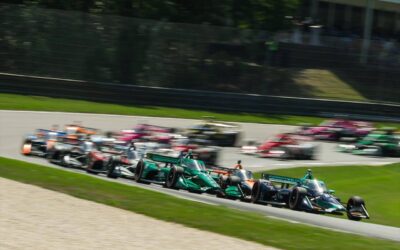The FIA World Endurance Championship (WEC) is a multi-class racing series with races spanning a minimum of six hours, approaching its 12th season. ATRL’s Chiara Schanno takes a look at what you need to know about WEC.
Learning the Basics
In all standard WEC races, there are two classes competing at the same time: Hypercar and LMGT3. At Le Mans 24hr, a limited number of LMP2 cars (who were part of the regular WEC field last year) will also be allowed to compete.
Hypercars are built according to the Le Mans Hypercar (LMH) or Le Mans Daytona h (LMDh) regulations, with a Balance of Performance (BoP) system in place to level out the playing field for all manufacturers. All Hypercars use a hybrid engine and Michelin tyres. The LMGT3 class uses cars in compliance with the FIA GT3 regulations that are based on road production cars and their tyres are provided by Goodyear. Across the series, 100% sustainable fuel is used.

2023 Hypercar Manufacturers’ Champions Toyota and Drivers’ Champions of the #8 car during the official WEC test (“Prologue”) at Lusail International Circuit. (Photo via @tgreurope on Instagram)
The permanent WEC field comprises 37 entries, 19 Hypercar and 18 LMGT3, with each entry typically having three drivers. WEC uses the official FIA driver categorisation which mandates which drivers can enter in which class. In Hypercar, no bronze drivers (lowest categorisation) are allowed. LMGT3 teams must field at least one bronze driver, making it a pro/am class as opposed to Hypercar being a strict pro class. The remaining driver(s) of a LMGT3 entry can be of either bronze and/or silver category. Depending on the duration of the race, LMGT3 drivers have minimum and maximum driving times that are the same for bronze and silver drivers. Hypercar drivers don’t have minimum driving times.
Championships
In WEC, there are five different championships to claim, three in the Hypercar class and two in the LMGT3 class.
Hypercar:
- FIA Hypercar World Endurance Drivers’ Championship
- FIA Hypercar World Endurance Manufacturers’ Championship (Manufacturers/works entries)
- FIA World Cup for Hypercar Teams (Privateer entries)
If a works entry manufacturer has more than one car, they only receive points for their higher placed entry. The World Cup is ranked by cars, not teams, meaning if a team enters multiple cars, all cars can score points and are in direct competitions with each other.
LMGT3
- FIA Endurance Trophy for LMGT3 Drivers
- FIA Endurance Trophy for LMGT3 Teams (Privateer entries)
The reigning Hypercar drivers’ champions are Sébastien Buemi, Brendon Hartley and Ryō Hirakawa of the Toyota #8. Toyota is also the reigning Manufacturers’ champion. Hertz Team Jota won the Hypercar World Cup for Teams in 2023. As LMGT3 is new to WEC in 2024, there is no reigning championship for drivers or teams.
Weekend format
Typically there are three Free Practice sessions spread over two days, where all cars and drivers get the opportunity to understand the track and develop their car setup. During those sessions, teams may switch drivers and refuel the car as often as they want. All cars can use a maximum of 12 different pre-allocated tyres. Teams can mix sets and compounds from their allocated tyre pool. All drivers must set a lap time within 110% of the best lap time over all practice sessions in their class in order to be allowed to compete. If part of the race takes place during the night/dark, all drivers must also drive at least 5 laps during practice by night/dark.
Qualifying takes place on Day 2 and is divided by class into two sessions each. The fastest ten cars in the first session will then compete in the Hyperpole qualifying. The start order of the top 10 is exclusively determined by the times set in Hyperpole, and 11th place and lower are determined by the first qualifying session. In LMGT3, only bronze drivers can participate in qualifying and Hyperpole. During both sessions, it is forbidden to refuel the cars and to enter the garage before the end of the session. Teams must usually use the softest available tyre compound during qualifying and Hyperpole. Qatar is an exception where they have to use the hardest available compound. During qualifying, they may change tyres, but they are not allowed during Hyperpole. Cars are placed under parc-fermé once they start qualifying. If a car causes a red flag, their lap time(s) will be deleted and they are not allowed to rejoin the session.

Toyota’s #7 car during the official WEC test (“Prologue”) at Lusail International Circuit. (Photo via @tgreurope on Instagram)
On Day 3, the race is started according to the qualifying and Hyperpole results, with all Hypercars ahead of LMGT3 cars.There is a rolling start after two formation laps, with cars not being allowed to overtake before crossing the start line. During the first three laps of Safety Car period or during a Full Course Yellow, cars are not allowed to pit barring emergencies. Per FCY phase, only one emergency stop per car is permitted. Once the race restarts, any cars that stopped under FCY or in the first three laps of SC period must enter the pits again. During a VSC period, the pit entry stays open. A VSC period will always be followed by a SC period. During a VSC there is a speed limit of 80 km/h.
Teams are allowed to change any tyres and can mix sets and compounds. If needed, they can only change one tyre (e.g. due to higher stress due to the track layout). If a team refuels and changes all tyres, it’s often referred to as a full service (stop) and usually indicative that they will do a driver change either this or the next pit stop.
Seven out of eight races this season are primarily limited by time.
Once the allocated race time has passed, all cars are only allowed to complete their current laps and cross the finish line. The Qatar 1812 km is slightly different as this race is attempting to complete a certain distance and therefore lap count (335 laps). The chequered flag is shown either at the end of the 335th lap or after 10 hours, as the race also has a time limit.
Points attribution
Points attribution depends on the length of the race.
For 6h races, the top ten score points according to the standard scheme of 1st 25 points, 2nd 18 points, 3rd 15 points, etc., all the way down to 10th place scoring 1 point.
For 8h races, 10h races and races of 1812 km, this scoring system is multiplied by 1.5 with numbers being rounded up if necessary. This means 1st place scores 38 points, 2nd place 27 points, 3rd place 23 points and so on, up to 10th place who is awarded 2 points.
For the 24 Hours of Le Mans, the normal points system is doubled, so 1st place receives 50 points, 2nd place 36 points, 3rd place 30 points etc., with 10th place scoring 2 points.
In each category, a point for pole position is awarded to the team and all drivers of the car setting the fastest lap in Hyperpole.
How to Watch
This year’s WEC calendar has eight rounds. The dates for all races can be found on www.fiawec.com or the WEC app, where you can also find full schedules for each race before the race weekend. They also have free live timings for all sessions, including race control messages and the full teams & drivers lineup.
To watch WEC, subscribe to WEC TV or check the WEC website/app for their broadcast guide for each race. The Qatar broadcast guide can be found here.
ABOUT THE AUTHOR

Chiara Schanno was introduced to Motorsport through their family at a young age. Getting really into F1 in late 2016, they soon started to watch more series and is now particularly interested in electric racing like Formula E and feeder series racing like Formula 2. A non-motorsport related (fun) fact about Chiara is that they have stage experience in both acting and singing. They are based in Germany.
Related Articles
How Formula 1 Tackles Mental Health Stigma in the Sport and Beyond
In the second piece of a series, ATRL’s Ayesha Ninan explores Formula 1’s evolving approach to mental health, highlighting systemic changes and impactful partnerships such as McLaren’s collaboration with the mental health charity Mind.
Accelerating Awareness of Mental Health in Motorsport
In this three-part series, ATRL’s Ayesha Ninan explores Formula 1’s approach toward destigmatizing mental health. The series details the sport’s journey from neglecting mental well-being to integrating enhanced support systems for its drivers and teams, highlighting individual experiences and broader cultural shifts within the high-pressure environment of Formula 1 racing.
Hitting the Apex: Children’s of Alabama Indy Grand Prix
The 2024 IndyCar season continues with its first road-course race at Barber Motorsports Park. All eyes will be on Team Penske as Josef Newgarden seeks redemption after this week’s news of a St. Pete’s DSQ impacted his championship lead.
Stay Up to Date With The Latest News & Updates
Interested in Writing for ATRL?
Contact us now! Fill out the form below and wait for an email from us to get started.
Join Our Newsletter
Subscribe to updates when we post a new article!
COMING SOON!
Follow Us
Follow us on Twitter and Instagram @ATRacingLine




Recent Comments